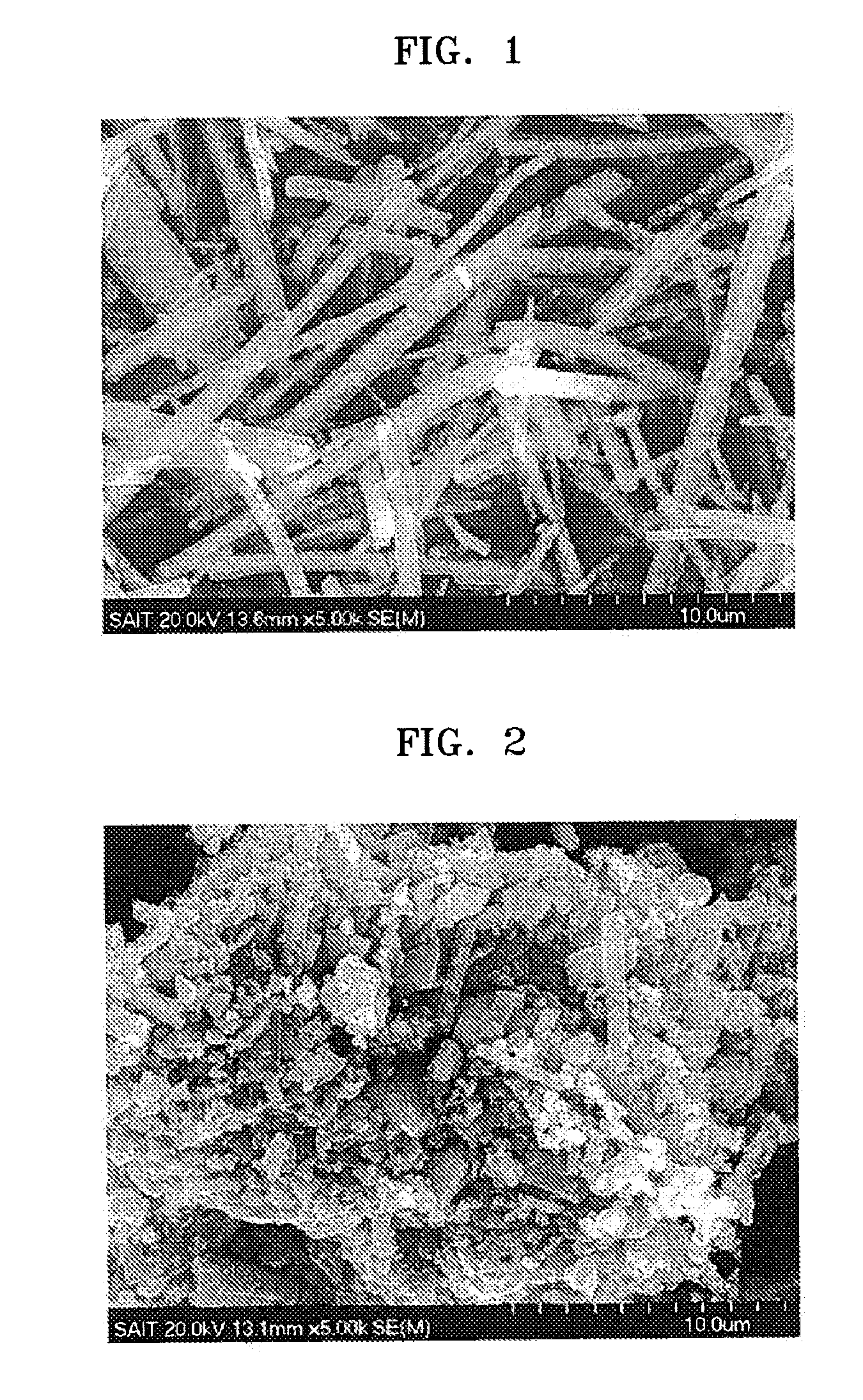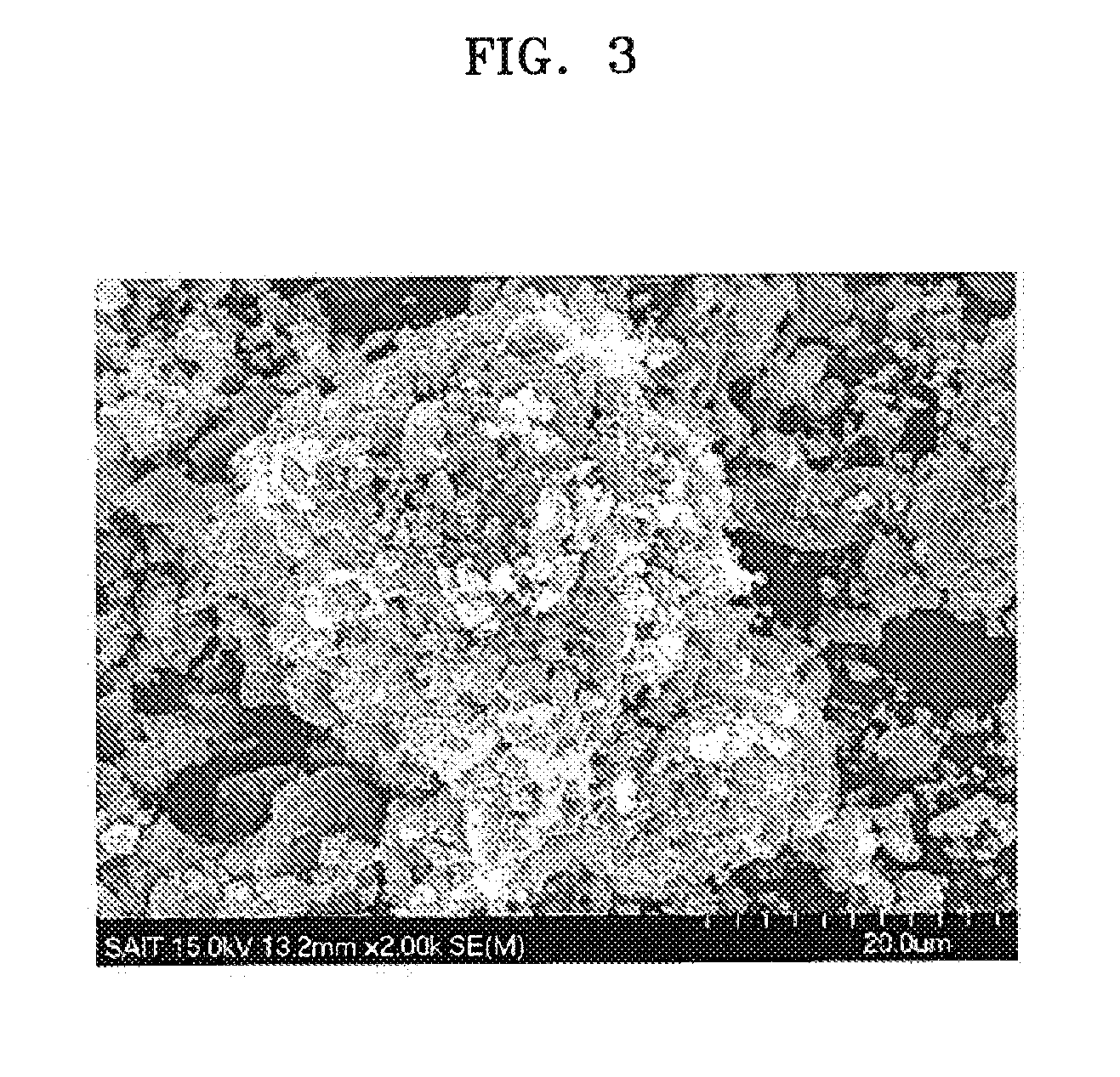Anode active material and method of preparing the same
a technology of active materials and anodes, which is applied in the manufacture of electrodes, cell components, conductors, etc., can solve the problems of shortening the internal space between the anode and the cathode, reducing the charging and discharging efficiency, and accumulating large amounts of lithium on the surface, so as to improve the battery cycle characteristics
- Summary
- Abstract
- Description
- Claims
- Application Information
AI Technical Summary
Benefits of technology
Problems solved by technology
Method used
Image
Examples
example 1
[0064]19 g of cobalt acetate tetrahydrate and 10 g of trimesic acid were dissolved in 1000 mL distilled water and agitated at room temperature for 10 hours. Then, the obtained powder was filtered using a nylon filter, washed several times, and dried in an oven at 80° C. for 12 hours to obtain fibrous coordinate polymer particles. The obtained fibrous coordinate polymer particles were subjected to heat treatment under a flow of argon gas at 900° C. for 10 hours, thereby preparing fibrous carbon-cobalt composite particles. FIG. 1 is a Scanning Electron Microscope (SEM) image of the fibrous carbon-cobalt composite particles prepared according to Example 1.
Preparation of Anode Active Material
example 2
[0065]1 g of metallic silicon powder having an average particle diameter smaller than 43 μm, 0.05 g of the fibrous carbon-cobalt composite particles prepared in Example 1, and 1 g of polyvinyl alcohol (PVA) powder having a number average molecular weight of 500 were mixed, and pulverized for 30 minutes using a high-energy mechanical milling machine (e.g. SPEX 8000M device commercially available from SPEX CertiPrep Inc.). 0.05 g of carbon-cobalt composite particles were mixed in to the pulverized product, and the PVA of the resultant product was then completely carbonized by subjecting the resultant product to heat treatment under a flow of argon gas at 900° C. for 10 hours, thereby preparing the anode active material.
[0066]FIG. 2 is a SEM image of the anode active material prepared according to Example 2. The anode active material was found to have three-dimensional irregular arrays of metallic silicon powder and fibrous carbon-cobalt composite particles, as confirmed by the SEM ima...
example 3
[0069]3.3 g of the powder obtained by pulverizing the anode active material prepared according to Example 2 using a mortar and pestle, 5.7 g of graphite powder having an average particle diameter of 2 μm, and 20 g (5 wt %) of polyvinylidene difluoride (PVdF) were mixed. 5 mL N-methylpyrrolidone (NMP) was added to the mixture, and then the resultant product was stirred using a mechanical agitator for 60 minutes, thereby preparing a slurry.
[0070]The slurry was coated on a copper (Cu) current collector to a thickness of about 200 μm using a doctor blade, dried, and then dried again under vacuum at 110° C., thereby preparing an anode.
PUM
 Login to View More
Login to View More Abstract
Description
Claims
Application Information
 Login to View More
Login to View More - R&D
- Intellectual Property
- Life Sciences
- Materials
- Tech Scout
- Unparalleled Data Quality
- Higher Quality Content
- 60% Fewer Hallucinations
Browse by: Latest US Patents, China's latest patents, Technical Efficacy Thesaurus, Application Domain, Technology Topic, Popular Technical Reports.
© 2025 PatSnap. All rights reserved.Legal|Privacy policy|Modern Slavery Act Transparency Statement|Sitemap|About US| Contact US: help@patsnap.com



